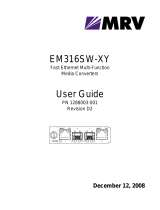Product Features
Front panel
The CBFTF1010-130 bridging media converter has three RJ-45 10/100Base-TX
ports. See illustration below.
Auto-Negotiation (selectable)
The Auto-Negotiation feature automatically configures the bridging media
converter to achieve the best possible mode of operation over a link. The bridging
media converter broadcasts its speed (10 Mbps or 100 Mbps) and duplex
capabilities (full or half) to the other devices and negotiates the best mode of
operation. Auto-Negotiation allows quick and easy installation because the optimal
link is established automatically—no user intervention required.
In a scenario where the media converter is linked to a non-negotiating device,
disable Auto-Negotiation. In this instance, the mode of operation will drop to the
least common denominator between the two devices (e.g., 10 Mbps, half-duplex).
Disabling this feature allows forcing the connection to the desired speed and duplex
mode.
Data transfer rate (selectable)
10Base-T data transfer rate: 10 Mbps Ethernet.
100Base-TX data transfer rate: 100 Mbps Ethernet.
Full-Duplex network (selectable)
In a full-duplex network, maximum cable lengths are determined by the type of
cables used. The 512-Bit Rule does not apply in a full-duplex network.
Half-Duplex network (selectable) (512-Bit Rule)
In a half-duplex network, the maximum cable lengths are determined by the round
trip delay limitations of each fast Ethernet collision domain. (A collision domain is
the longest path between any two terminal devices, e.g., terminal, switch, or router.)
The 512-Bit Rule determines the maximum length of cable permitted by calculating
the round-trip delay in bit times (BT) of a particular collision domain. If the result is
less than or equal to 512 BT, the path is good.
AutoCross™
When the AutoCross feature is activated, it allows either straight-through MDI or
crossover MDI-X cables to be used when connecting to 10Base-T or 100Base-TX
devices. AutoCross determines the characteristics of the connection and
automatically configures the unit to link up, regardless if the cable configuration is
MDI or MDI-X. This feature is permanently enabled.
2
Port 1 Port 3
BLK PRI PWR
CBFTF
Port 2
CBFTF1010-130
Technical Support: 1.800.466.4526. Press "2" -- International: 1.408.744.2751
Installation
Note: Wear a grounding strap when removing the circuit board from its anti-static
bag.
Jumpers
The two, 3-pin headers located on the inner surface of the board are used to select
“hardware” and “software” modes, and “redundancy.” See photo below.
• Hardware Mode: DIP switches control the function of the board. You can view
status only via the Web or Focal Point interface.
• Software Mode: Software controls the function of the board. The DIP switches do
not function in software mode.
• Redundancy: automatically switches data transfer responsibilities to the secondary
port if the primary port fails.
3
CBFTF1010-130
Product features -- continued
Redundancy (selectable)
With redundancy enable and the primary port fails, the converter automatically
switches data transfer responsibilities to the backup port without disrupting network
traffic. After the primary port's failure is resolved, the converter automatically
switches data transfer responsibilities back to the primary port.
Parallel detection
Parallel detection is the method used to link when an auto negotiating port detects a
link partner that is in forced mode and therefore cannot participate in the auto
negotiating process. Parallel Detection can be set to IEEE Standard half duplex, or
the non-standard full duplex. Switch settings for parallel detection are valid in
hardware or software mode, only when Auto-Negotiation is enabled.
Per the IEEE method, an auto negotiating port that detects a forced link partner
should drop to the detected speed (10Mbs or 100Mbs) and default to half duplex
The BFTF-130 allows bypassing the IEEE method by setting the parallel detection
default mode to half or full duplex via DIP switch 3.
(Shunt in Default Position)
Letter "H" = Hardware
J4 (3-Pin Header)
J2 (3-Pin Header)
Letter "S" = Software
Letter "R" = Redundant
Shunt in Redundant Position
(Default)









